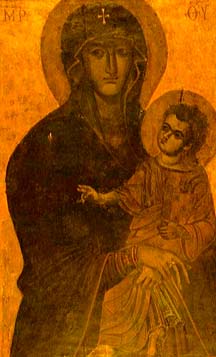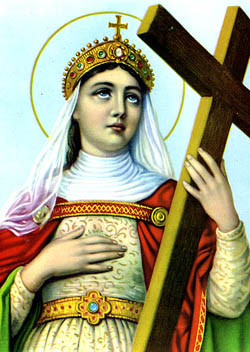
|
OUR LADY OF FATIMA CRUSADER BULLETIN |
Vol. 41, Issue No. 114 |
| Saint Helena |
Our Lady of the Snows
 Our Lady's Sign.... A Snowfall. This is the history of Our Lady of the Snows. The time was the year 352, so soon after the birth of Jesus that many did not know about Him, and many "dared" not know, for fear of persecution.
Our Lady's Sign.... A Snowfall. This is the history of Our Lady of the Snows. The time was the year 352, so soon after the birth of Jesus that many did not know about Him, and many "dared" not know, for fear of persecution.
The city of Rome, Italy, was fast becoming a Catholic center, and there resided Pope Liberius, the Holy Father, Successor of the Holy Apostle, St. Peter. Among his loyal subjects were a noble patrician, John, and his wife. This couple was very holy and devout.
They were not blessed with children, so it was their desire that their worldly goods should be given to the Mother of God. They discussed this with Pope Liberius and he counseled them to commend this holy intention to the Blessed Virgin Mary. Fervently, they besought her to show them her desire by some sign.
During the night of August 5th, the Virgin Mary appeared to John and his wife, and also to Pope Liberius, telling them to construct a church in her honor on the crest of the Esquiline Hill. As a sign of her will, she told them, they would find it covered with snow.
Snow is rare in Rome. When it falls, it is a day of rejoicing, and the populace delights in the beautiful sight of trees and shrubs blanketed with a soft mantle of white. Many winters pass without the least trace of a snowfall.
Imagine the great excitement of a snowfall during the first days of the hot month of August. That is exactly what happened on the night of August 5th, 352. In the morning, almost all of Rome thronged to the Esquiline Hill as the news spread that snow had fallen there during the sultry night, outlining the precise shape of the church requested by Our Lady. John, his wife, and Pope Liberius, told the crowd the snow was a favor from the Immaculate Queen of Heaven. When the people learned this, they shouted over and over again, "Our Lady of the Snows!"
The crest of the Esquiline hill, therefore, became the site of a church dedicated to the Mother of God, just as she wished. This was ancient Rome, early in Christianity, only 352 a.d. - almost sixteen hundred and fifty years ago! This was the origin of the title: Our Lady of the Snows.
The church built in her honor is known today as the Basilica of Saint Mary Major (Santa Maria Maggiore), because it is the Mother of all churches throughout the world dedicated to our Heavenly Queen. This church in Rome is the original Shrine of Our Lady of the Snows. In honor of Pope St. Liberius (who suffered exile during the Arian heresy), it is also called the "Liberian Basilica."
The altar of Our Lady's Basilica contains the relics of the manger crib of Our Divine Lord, which St. Helena brought back from Jerusalem with the True Cross. The image honored as Our Lady of the Snows is a venerable painting of the Madonna and Child in Greek style, attributed to the physician-Evangelist, St. Luke. Relics of many apostles and saints, as well as the body of St. Matthew and the head of St. Luke rest in this favored sanctuary.
The Greatest Marian Church throughout History. Down through the sixteen centuries since the first construction of the Basilica, pilgrims from all regions of Christendom have made Saint Mary Major one of the most popular churches in the world. Our Lady of the Snows has found pleasure in showering down countless blessings upon her children who invoke her under this particular title.
Throughout the annals of Church History, we find many a Saint greatly devoted to this magnificent Church of Our Lady.
The Popes of the past have had a tender devotion towards the Madonna of the Esquiline, and have tried to outdo one another in enriching this Mother Church dedicated to her honor. The present magnificent edifice was constructed in the fifth century by Pope Sixtus III. The compartments of the intricate ceiling were gilded with the first gold brought from America by the devout Catholic explorer, Christopher Columbus. St. Gregory the Great turned to Our Lady during the devastating black plague in Rome in 597, and had her miraculous image carried in procession from St. Mary Major to St. Peter's Basilica; and St. Michael appeared in the sky to indicate the end of the pestilence. The tomb of Pope St. Pius V lay for centuries in the Chapel of the Blessed Sacrament, where St. Ignatius Loyola said his first Mass. Eugenio Pacelli (the future Pope Pius XII), also said his first Mass at the altar of Our Lady of the Snows in 1899. It is obvious why She is frequently referred to as the "Madonna of the Popes." Many other examples can be taken from the lives of the Popes and Saints who lived in Rome, manifesting their tender devotion to St. Mary Major, the "Shrine of Our Lady of the Snows." St. Stanislaus Kostka even used to turn in his cell to pray facing St. Mary Major.
Thus, has this beautiful title come down from Christian antiquity.
One lovely custom of olden times has come down even to our era. During Mass and Vespers each year on the Feast of Our Lady of the Snows (Aug. 5), the glorious anniversary of the origin of the Basilica is celebrated with pomp and splendor. Recalling the miraculous fall of snow that indicated the site of this Mother Church of Mary, a shower of rose petals, jasmine, and other white flowers are let to fall from the ceiling at the words: "He sendeth His snow like wool..."
The white jasmine symbolizes the purity and innocence of the Blessed Virgin Mary. The way the flowers are scattered from above suggests the manner in which Our Lady showers her graces on all souls, but in a particular manner upon those who honor her under the title of Our Lady of the Snows.
Throughout the thirty-some years of our apostolate, Our Lady has manifested herself under this special title in ways especially dear to those who cherish the providential significance of this wonderful title of the Immaculate Queen of Heaven; and we look forward to her continued protection and guidance, safe beneath the white flowing mantle of her heavenly grace.
Prayer
Our Lady of the Snows, Immaculate Queen of the Universe, from this privileged sanctuary, Thou has bestowed so many countless graces and pledges of love upon the hearts and souls of millions. O Mother, from this cradle of Christianity, this Mother Church of all churches, deign to shower forth the graces of thine Immaculate Heart upon the remnant Faithful throughout the world, wherever they may be, and grant them the graces of a childlike love and unwavering fidelity to the holy truths of our Faith. Grant, good Mother, to the faithful Bishops of the Church the grace to defend Her Sacred Teachings, and to persevere courageously against all the enemies of the Holy Church. Amen.
 Glorious Champions of the Holy Catholic Faith
Glorious Champions of the Holy Catholic Faith
The Great Empress St. Helena
According to tradition, the great and holy Helena lived in the German holy city of Trier, which later became a major center of the Roman Empire under the venerable Catholic emperor Constantine. (Although Constantine, like most other great Catholic monarchs has been terribly maligned by the falsified 'historical" accounts of Freemasonic, Modernist, secular, Protestant and British "historians," the authentic accounts of Church history tell us quite accurately that he was truly a great and holy defender of the Catholic Faith and Christ's One, True Church. Indeed, the eastern Church has always honored him as a saint and the awesome basilica of Constantine in Trier bears witness to his having been also honored as a saint in much of the early Latin Church.)
The incomparable faith and piety of Saint Helena greatly influenced her son Constantine, the first Christian Emperor, and served to kindle a holy zeal in the hearts of the people of the Roman Empire. Forgetful of her high dignity, she delighted to assist at the Divine Office amid the poor; and by her alms-deeds showed herself a mother to the indigent and distressed. In her eightieth year she made a pilgrimage to Jerusalem, with the ardent desire of discovering the Cross on which Our Blessed Redeemer suffered. After many labors, three crosses were found on Mount Calvary, together with the nails and the inscription recorded by the Evangelists. It still remained to identify the true Cross of Our Lord. By the advice of the Bishop, Macarius, the three were applied successively to a woman afflicted with an incurable disease, and no sooner had the third touched her than she arose, perfectly healed. The pious Empress, transported with joy, built a most glorious church on Mount Calvary to receive the precious relic, sending portions of it to Rome, Trier, and Constantinople, where they were solemnly exposed to the adoration of the faithful. In the year 312, Constantine, while encamped with the imperial troops in Germany, found himself attacked by the heathen Maxentius with vastly superior forces, and the very existence of his Empire threatened. In this crisis he bethought himself of the Christian God Whom his mother Helena worshipped, and kneeling down, prayed God to reveal Himself and give him victory. Suddenly, at noonday, a cross of fire was seen by his army in the calm and cloudless sky, and beneath it the words, "In Hoc Signo Vinces" C "In this Sign you shall conquer." By Divine command, Constantine made a standard like the Cross he had seen, which was borne at the head of his troops; and under this Christian ensign they marched against the enemy, and obtained a complete victory. Shortly after, St. Helena herself returned from her beloved city of Trier (where today is found the magnificent basilica of the seamless Robe of Christ left there by St. Helena) to Rome, where she expired in 328. Her feast is observed on August 18.
Reflection: St. Helena thought it the glory of her life to find the Cross of Christ, and to raise a temple in Its honor. How many Christians in these days are ashamed to make this life-giving sign, and to confess themselves the followers of the Crucified!
Back to Marian Apparitions ... Back to Top
Back to Bulletins ... Back to Saints
Visit also: www.marienfried.com
